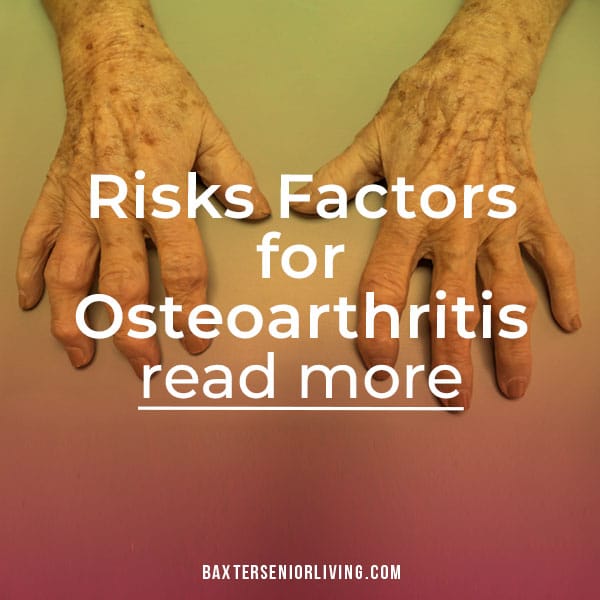It might surprise you to learn that there are over 100 types of arthritis. Osteoarthritis is the most common and common problem many people over 50 have, even if their symptoms are only mild. Osteoarthritis (OA) is a degenerative joint disorder marked by progressive destruction of the joint cartilage and bony overgrowth into the joint space. Joint damage occurs when repeated stress causes normal joint cartilage to wear away faster than it can regenerate.
Let’s look at the 5 most important risk factors for osteoarthritis.
Increasing Age
The most common cause of osteoarthritis in young adults is either a severe injury to the joint where the disease manifests, or a genetic variant that makes their cartilage weak from birth. In older people, lifestyle and the aging process are bigger factors. The odds of getting osteoarthritis rises after the fifth decade. It’s not surprising that joints deteriorate with age. The activities of life place force on joint cartilage. In response to the overload, cartilage-producing cells produce more matrix. However, this system becomes less efficient with age. Experts also believe that the aging of non-cartilage tissues may contribute to osteoarthritis.
Obesity
Besides maturity, obesity is the biggest risk factor for osteoarthritis. One reason for the increased risk is that each pound of extra body weight increases the force on a joint by 3 to 4 times. One study found that people with a BMI (body mass index) of greater than 30 had a 6.8 times greater risk of developing osteoarthritis of the knee. Research also shows almost 70% of knee replacements and 27% of hip replacements are related to obesity.
While the added force that extra weight places on the knees is one factor, studies show obese people have a higher risk of arthritis in non-weight-bearing joints like the fingers or hands. So, there seems to be another factor at play. Since fat cells release inflammatory chemicals, this may be a factor too.
The good news? Losing as little as 5 or 10 pounds takes some pressure off your joints. If you already have osteoarthritis, even a small amount of weight loss can improve your symptoms. Weight loss helps by taking force off the knee joints.
History of an Injury
If you’ve ever had a significant injury to a joint, you may be at a higher risk of osteoarthritis later on. A common type of injury that can lead to osteoarthritis is a torn ligament or torn cartilage in the knee. Also, fractures of the patella or knee bone raise the risk. One study found that over 11% of people who injured a knee developed osteoarthritis over 19 years.
Exercise, which builds the muscles around your joints, helps stabilize and protect your knees. Plus, exercise will help you develop better coordination and balance, reducing the risk of falls that can damage your joints. But be sure you’re using the correct form, wearing the right shoes, and doing a proper warm-up before launching into a workout. Give your body time to rest and recover between training sessions too. Vary the type of workouts you do, so you’re not placing repetitive force on your joints.
Repetitive Joint Stress
If you do a strenuous job or a job that places repetitive stress on your joints, you may be at greater risk of osteoarthritis. For example, heavy physical labor increases the risk of developing osteoarthritis in both hands and knees. That’s true even after controlling for age and body mass index (BMI).
In one large meta-analysis of 71 studies, researchers found that people who work in construction, miners, house cleaners, and agricultural workers have a higher risk of joint degeneration and osteoarthritis. Squatting repeatedly, lifting, climbing stairs, and kneeling repetitively all increase the risk of knee arthritis. However, exercises like squats and lifting recreationally may be beneficial, as exercise strengthens the quadriceps muscles that support and stabilize the knee.
Genetics
As with many health problems, genetics is also a factor for osteoarthritis. A 2004 study found that half of the predisposition to develop osteoarthritis can be attributed to genetics. This doesn’t mean that lifestyle factors, like weight loss, don’t offer benefits. It’s even more important to stay at a healthy body weight if you have a family history of osteoarthritis.
You can’t control some risk factors for osteoarthritis, like age and genetics, but you have some choice over how you use your joints, your body weight, and whether you develop an injury. Take advantage of what you can control, so you can keep your joints as healthy as possible as the years go by.


